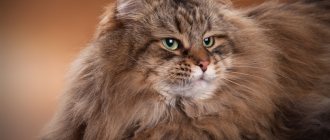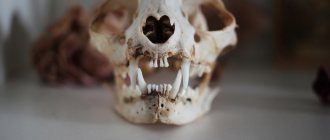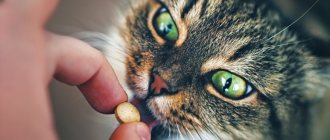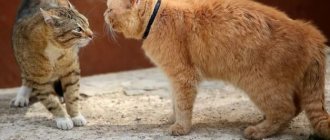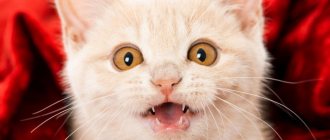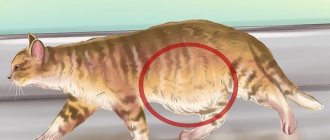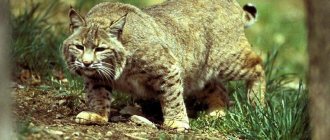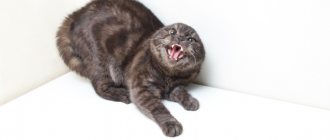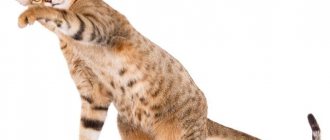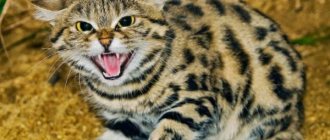Cat bones and joints
The graceful silhouette of cats is formed by the skeleton and muscles. Kittens can differ significantly in their proportions from adult animals. Often teenagers seem angular and awkward. A newborn kitten already has the necessary set of muscles, ligaments, bones and joints. During the growth process, their number does not increase, only their sizes change.
Bones are a hard organ consisting primarily of bone tissue. The bone structure also includes nerves, blood vessels, cartilage, and periosteum. Bone tissue is made up of minerals (mainly calcium and phosphorus).
The skeleton forms the skeleton of a cat's body. Bones perform not only a musculoskeletal function, but also a protective function. The bones of the skull protect the brain from mechanical damage, and the ribs help keep the heart and other internal organs intact. On average, cats have about 240 bones. Their exact number depends on the length of the tail of each individual individual.
At the ends of the bones there is an epiphysis - soft cartilaginous tissue. It is she who is responsible for the growth of bones in kittens. Typically, active bone growth in cats is observed before they reach one year of age. Due to the soft epiphysis, the bones of kittens are very fragile, so they are often injured. After reaching one year of age, the pineal gland is saturated with minerals (mainly calcium) and hardens.
Cats have the following number of vertebrae:
- 7 cervical;
- 13 breast;
- 7 lumbar;
- 3 crosses;
- up to 24 tail.
The spine and skull serve to protect the central nervous system. The thoracic vertebrae, ribs and sternum form the rib cage. Cats do not have collarbones, and therefore the limbs and chest are attached to each other using strong muscles and tendons. Thanks to this feature, cats can jump from great heights.
The forelimbs consist of:
- radius;
- humerus;
- ulna;
- shoulder blades;
- wrists;
- the bones of the paw itself.
The hind limbs consist of:
- pelvic bone;
- hips;
- shins;
- kneecap;
- heels;
- metatarsal bones;
- phalanges of fingers.
Cats literally walk on their toes rather than stepping onto surfaces with their entire foot. The cat has 5 toes on the front paws (one of the toes is shortened and does not touch the surface when walking), and on the hind paws there are 4 toes (the thumb is missing, but you can see the heels). On the fingers there are leather pouches in which the claws are hidden. If desired, the cat can release them instantly.
The skull consists of the brain and facial sections. The first has 11 bones, and the second 14. The kitten erupts its teeth at three weeks of age. There are 26 of them in total. At about six months of age, they are completely replaced by permanent teeth.
Cats are predators, and the structural features of their jaw are associated with this fact. An adult animal has 30 teeth: 12 incisors, 4 canines, 10 premolars and 4 molars.
Joints are movable joints of the skeleton. In cats, there are three types of joints: synovial and cartilaginous, sutures. It is thanks to the joints that the cat's body is so mobile.
The cartilaginous joints of cats are highly flexible, allowing the animal to take various “uncomfortable” positions. The sutures are motionless; they are located between the fused parts of the skull. They have a fairly fibrous structure.
Synovial joints serve to move bones together. At the junction, the bone is covered with cartilage tissue, which is surrounded by a smooth capsule filled with synovial fluid. Due to the mobility of these joints, the cat can run fast and jump high.
We recommend the article: Why does a cat constantly stick out its tongue?
Navigating in space
Finally, it is worth mentioning what a cat’s sense organs are made of. This includes not only the eyes, ears and nose, but also the tongue and whiskers.
The vision of a genius
Whiskered pets see perfectly in the dark, distinguish 3 colors (red, blue, green) and as many as 25 shades of gray. The mysterious glow of their huge eyes at night is explained by the tapetum - a special vascular layer located behind the retina.
Thanks to the convex cornea, the viewing angle of these animals is almost 270°, so with the help of their necks they are able to assess the situation at all 360°.
Whiskers
The tactile function is performed by vibrissae, that is, cat whiskers. In fact, they also belong to hairs, but their follicles lie much deeper than the guard coat and undercoat. They actively interact with nerve impulses, determining the surrounding temperature, perceiving signals of pain and pleasant touches.
These tactile hairs are found not only on the face, but also on the hind legs. Because of this, mustachioed pets actively shake them when they step in the mud or enter the water.
Pulling or cutting mustaches is strictly prohibited. In addition to acute pain, the animal may permanently lose its tactile function, which will affect orientation in space and mental health.
Nose-sniffer
The cat's nose contains 80 million olfactory receptors, so its sensitivity is 2 times higher than that of humans. Additionally, the Jacobson's organ, a small tube located on the upper palate, is responsible for the perception of odors.
Another interesting fact is that the imprint of a wet cat’s nose, like the pads of human fingers, is unique. Thanks to this, it can easily be classified as biometric data.
Ears-on-top
The developed hearing of furry pets even detects ultrasound. Its ears, consisting of an outer, middle and inner part, are responsible for this. The task of the first is to collect sound, the second is to transmit a sound signal, and the third is to convert sound vibrations into nerve impulses.
Thanks to this feature, animals moving to the dacha in the summer can easily find their way back during their walks. Having moved away 3 km, they perfectly hear the voices of their owners and other sounds associated with a country house.
Tongue - lover of food
Despite night vision, an excellent sense of smell and acute hearing, cats are inferior to us in some ways. The tongue has only 473 taste buds, while the human tongue has as many as 9,000.
Whiskered pets are good at distinguishing sour, salty and bitter foods, but almost unable to detect sweet ones. The love for ice cream is explained by its similarity to milk, familiar from childhood. For this reason, treats should be avoided as animals become lactose intolerant as adults.
Separately, it is worth noting 2 special receptors that are not typical for humans. One recognizes the taste of umami, that is, monosodium glutamate, and the second recognizes the taste of water. This is why cats often steal sausages and have a special love for unstagnant tap water.
Cat muscles
It is the muscles, of which there are more than five hundred in cats, that are responsible for the movement of all parts of the animal’s body. They are divided into two types: smooth and striated.
Smooth muscles cover the internal organs. The cat cannot control them consciously. Striated muscles are attached to the skeleton and are responsible for the movement of the animal. Muscles are attached to bones by tendons made of fibrous tissue.
Cats have an unusual structure of the shoulder girdle. If a person has collarbones, with the help of which the limb is attached to the skeleton, then in cats the forelimbs are connected to the body with the help of muscles. This has to do with the way the cat moves. Thanks to this structure of the shoulder girdle, cats become more flexible. They can easily flip over in the air and use their front legs as a shock absorber.
The muscles on the hind legs are strong, thanks to this the animal can quickly gain speed and make high jumps.
Features of a cat's skeleton
The general structure of the cat's skeleton is similar to that of other mammals, with the exception of some differences in the shape and arrangement of individual bones, which is associated with the horizontal position of the spine and maximum adaptability to the lifestyle of a predator. In addition, differences in the shape and structure of individual bones may be due to breed characteristics. For example, Siamese have narrower and longer bones compared to Persian cats. From the photo below you can understand what a cat’s skeleton looks like without taking into account breeding characteristics.
The skeleton of a cat consists of an average of 244-250 bones. Some sources mention the figure 230-236, since some fused bones are considered as one whole. How many bones a cat has is influenced by the length of the animal's tail, since it contains almost a tenth of all the bones in a cat's body (a "normal" tail has about 26 vertebrae).
Cat skin and fur
The skin protects the animal’s body from external factors: radiation, microorganisms, chemical and mechanical damage. Wool also plays a protective function, but in addition it is responsible for temperature regulation of the body. Often, it is the quality and appearance of the coat that most eloquently indicates the health of the cat.
The epidermis is the outermost layer of the skin and performs a protective function. It is what protects the body from external factors. Essentially, the epidermis is dead skin cells that act as a barrier. Beneath them there are several layers of “living” cells - the basal layer. Next is the dermis, which contains capillaries, nerves, sebaceous glands and hair follicles.
The sebaceous glands produce oil, which makes the coat shiny. Glands located on the muzzle secrete a secretion that has a special smell and is used by cats to mark their territory. Between the fingers and near the anus there are also sebaceous glands that produce sex pheromone.
Each hair consists of cuticular cells that are layered on top of each other. From one follicle up to 6 guard hairs can grow, which are surrounded by soft and thin down. These fine hairs form a warm undercoat. Each follicle can lift hairs upward with the help of special muscles. Thanks to them, in case of danger, the cat's fur stands on end. A cat has whiskers or whiskers on its head. They perform a tactile function. The same shorter hairs grow throughout the animal's body.
Vision
Cats have a specific vision, which is why a lot of false hypotheses have arisen about it. Cats cannot see in pitch darkness; it’s just that if there is even the slightest source of light, she will be able to distinguish objects. The special structure of the eyes will allow the animal to navigate perfectly. The layer of cells behind the retina - the retina - reflects and amplifies unabsorbed light rays, which ensures sufficient visibility at dusk. As a result, the notorious “glowing eyes” effect occurs.
The shape of a cat's eyes can be almond-shaped, round or slanted. They are located close, directed in one direction, which creates stereoscopic vision.
In daylight, the pupil has the shape of a slit or oval; in poor lighting, it is dilated, almost round. If your animal's pupils are dilated during the day, it may be very agitated, under the influence of medication, or ill. A cat can distinguish six colors, but not as clearly as we can.
Cat's Breath
The respiratory system of a cat consists of the following organs:
- nose;
- nasopharynx;
- trachea;
- larynx;
- lungs;
- bronchi.
The respiratory system serves to supply the internal organs with oxygen.
In addition, it removes harmful gases and excess fluid from the body. The respiratory system is involved in thermoregulation of the body and, if necessary, it removes excess heat. Air from the nose enters the larynx and then through the bronchi it enters the lungs. The lungs are made up of small sacs called alveoli. It is they who, through their thin walls, saturate the blood with oxygen and remove carbon dioxide from it.
Cat's blood circulation
The main organ responsible for blood circulation in a cat’s body is the heart, a hollow muscular organ located in the chest. The ribs and muscles protect it from mechanical damage. The cat's heart consists of 2 ventricles and 2 atria.
Cats have two circles of blood circulation: large and small. Arteries and capillaries come from the heart and penetrate all internal organs. It is through them that all organs are saturated with oxygen - this is a large circle of blood circulation. During the pulmonary circulation, blood saturated with carbon dioxide enters the right ventricle of the heart, from there it is sent to the lungs, where it is again saturated with oxygen and returned to the heart muscle.
By feeling the artery in your cat's thigh, you can measure her pulse. Normally, it is about 100-150 beats per minute in adult animals, and about 150-190 beats per minute in kittens.
We recommend the article: What causes diarrhea in a cat?
Cat blood has a number of characteristics. It has a higher coagulability compared to humans. Blood consists of the following elements: plasma, red and white blood cells, platelets.
Red blood cells are responsible for saturating the body with oxygen, white blood cells are responsible for immunity and protect the body from germs and viruses, platelets are responsible for blood clotting. Plasma serves to transport and distribute nutrients and remove waste from the body.
Scull
It, like other bone elements, differs in some features. First of all, it is worth noting that the brain and facial parts of a cat are developed approximately equally. The first includes 11, and the second - 13 elements. The skull has a rounded shape. It has large eye sockets. There are also powerful and short jaws with very sharp teeth. The large size of the eye pits is determined by the lifestyle. Due to the size of these areas, cats can hunt successfully in low light conditions (at dawn or dusk). Powerful jaws act as the main attribute of a predatory animal. The lower part is suspended from the skull. It consists of horizontal and vertical segments. These parts break very easily when colliding with a car on the road. The size of an adult animal's skull depends on a number of factors. The size is affected by breed and gender. Individual hereditary characteristics are also important. If you look at what a cat's skeleton looks like, you can see that the bones in the skull are much larger than in the facial part. This specific feature makes the appearance of the animal unlike that of other representatives of the fauna.
Brain and endocrine system
The brain is the central organ of the nervous system. It analyzes the signals received through the nerve endings and converts them into commands that it gives to the animal’s body. Although this organ makes up 1% of a cat's body weight, it uses about 20% of the blood pumped by the heart muscle.
The brain is made up of neurons. The two hemispheres are responsible for the animal's emotions, learning and behavior. The cerebellum is responsible for movement. The brain is attached to the peripheral nervous system via the brainstem. Cats do not rely entirely on instinct. They learn to interact with the outside world and other living beings. The cat's behavior can be corrected. Little kittens need socialization and constant contact with humans, otherwise they will become wild. At an older age, it will be much more difficult to accustom them.
Hormones play a major role in the functioning of a cat’s body. The hypothalamus produces antidiuretic hormone (affects the composition of urine), corticoliberin (thanks to this hormone, the adrenal glands secrete cortisol in response to danger), oxytocin (affects milk production, and also plays an important role during pregnancy and childbirth). The pituitary gland produces growth hormones.
The adrenal glands are an important part of the endocrine system. They secrete cortisol, which helps to respond to injuries in a timely manner. They also secrete epinephrine, this hormone regulates the heart rate, and the frequency of dilation of blood vessels also depends on it.
What is anatomy?
Anatomy is a branch of science devoted to the study of the structure of the bodies of various creatures. Anatomy helps to establish the common features inherent in a particular species of animal. This science studies the external characteristics of species, the location of internal organs relative to each other, and clarifies their significance and functions.
Anatomy includes the following areas of science:
- osteology, which studies bone structures;
- myology, which studies the structure of muscle fibers, the location of muscles and the characteristics of their work;
- syndesmology, which studies the elements connecting parts of the skeleton;
- angiology, which studies blood vessels, lymphatic and circulatory systems;
- neurology, aimed at studying the functions of nodes and parts of the nervous system;
- splanchnology, systematizing knowledge about the structure of the respiratory, digestive, excretory and reproductive organs;
- endocrinology, explaining the significance of the endocrine glands;
- aesthesiology, which studies the functioning of the senses.
These scientific disciplines make it possible to trace how the formation of the most important systems occurs, as well as to establish their interrelationships. By studying the anatomy of a cat, you can find out what distinguishes it from other mammals. Anatomical knowledge allows us to understand the purpose of certain structures of the body.
Nervous system of a cat
The nervous system connects the entire body together and ensures its effective functioning. Nerve fibers are located throughout the animal's body. In response to stimuli, they transmit electrical impulses to the brain and spinal cord.
The central nervous system is divided into several segments:
- Brain.
- Spinal cord.
- Brain stem.
The nerves that are found throughout a cat's body make up the peripheral nervous system. It is she who is responsible for receiving information and transmitting signals to the central nervous system. In addition, it transmits brain commands to different parts of the body.
The autonomic nervous system is a group of nerves that transmit signals to the heart, blood vessels, and bladder. This system operates autonomously; the cat cannot control it consciously.
Kittens are born with an incompletely formed nervous system. They have little control over their body, mostly sleep and eat. In addition, kittens are born blind and deaf. The kitten learns to more or less control its body and stand on its paws around the third week of life. At the same time, the eyes open. Hearing is fully formed by 4 weeks. After another couple of weeks, the kitten begins to actively run and jump.
Deviations in the internal and external structure of cats
Sometimes kittens are born with anomalies of external or internal structure. The reason is disturbances in intrauterine development (for example, due to exposure to toxins on the embryo) or genetic failures. There are thousands of types of deviations; it is impossible to list them all in one article. Here are the most common:
- Polydactyly is a pathology in which a kitten is born with 6 or more toes. There are cases of oligodactyly, when one or more fingers are missing.
- Micromelia - the front legs are too short, the pathology is also called “kangaroo disease”.
- Syndrome of flattened chest, in which it is 3–5 times shorter than normal in length (but wider). The pathology is dangerous because it interferes with the cat’s breathing.
- Transposition of the heart is the location of the organ on the wrong side. As a rule, this pathology is not accompanied by any complications and does not in any way affect the cat’s well-being.
- Pituitary dwarfism is a delay in growth and physical development caused by underdevelopment of the organs of the endocrine system and, as a consequence, insufficiency of produced hormones.
- Hip dysplasia is underdevelopment of the joints, which leads to shortened paws and their weakness (the animal constantly limps and is prone to dislocations and fractures).
- Megaesophagus is a pathology of the digestive system in which a kitten is born with an enlarged esophagus.
- Neuroaxonal dystrophy is an anomaly of the nervous system associated with underdevelopment of the brain.
An example of polydactyly is a cat with 7 toes on its front paws, whereas normally there should be 5
Important: many deviations in the external structure that arose unintentionally (without human participation) are initially considered deviations, but later become the basis for a new breed and are recognized as the norm. Example: curled ears, lack of tail or fur, too short legs or body, etc.
A cat is an animal with an interesting internal and external structure. It has something in common with human physiology and anatomy, but there are still more differences. The entire structure of its body is the result of evolution: nature has endowed the animal with the ability to hunt, run quickly, nimbly climb, jump high and easily adapt to changing conditions.
Cat's sense organs
Of all mammals, cats boast some of the largest eyes relative to their overall body size. The eyes are located in front of the muzzle. Thanks to the special structure and location of the eyes, a cat can almost accurately determine the distance to certain objects.
The iris of the eye is very mobile, so the pupil can easily change its shape. Thanks to this feature, the cat’s very sensitive eyes do not experience discomfort in bright light. Cats have very sharp eyesight, and they can navigate well in the dark. They have a nictitating membrane, or third eyelid. It serves to protect against foreign objects and debris and also helps to moisturize the surface of the eye.
We recommend the article: What do black dots in a cat’s fur indicate?
The ears are located on top of the head. They often have a triangular shape. The ear consists of the following sections: auditory canal, eardrum, middle ear bone, cochlea, vestibular apparatus, auditory nerve. Cats have very sensitive hearing. They are able to distinguish more than 100 different sounds.
Smells are very important in a cat’s life, since with their help she marks her territory, communicates, distinguishes her own from strangers, and determines how edible this or that food is. The turbinates are lined with sticky membranes that trap odors. Cats also have a Jacobs organ in the roof of their mouth; it is a small tube, no more than a centimeter long, which is simultaneously sensitive to both smells and tastes.
A cat's tongue is covered with taste buds. They are able to distinguish between salty, bitter, sweet and sour tastes. The tongue is also covered with horny hooks, with the help of which the cat cleans its fur.
Cats' paw pads are very sensitive, which is why the animal often prefers to touch the object it wants to examine with its paw. Also, the cat's entire body is covered with tactile hairs.
Adrenal glands
Table 2 describes the ultrasonographic localization of the left and right adrenal glands in the dog and cat.
Dog
The adrenal glands in dogs appear as long, thin structures. The left adrenal gland is often peanut shaped in small breed dogs (Figure 11A); it may resemble a pancake or chaise lounge shape in medium to large breed dogs. The right adrenal gland in small breed dogs is usually oval; in dogs of medium and large breeds - pancake or V-shaped. The generally accepted norm for the height of the caudal pole of the adrenal glands in dogs is from 0.5 to 0.741; however, recent studies have suggested taking into account the patient's body weight to more accurately estimate gland size
Clinical studies and additional diagnostic tests should be taken into account when interpreting adrenal gland sizes.
Cat
The adrenal glands in cats are typically oval or bean-shaped, bilaterally symmetrical in size, and hypoechoic relative to the surrounding retroperitoneal fat. For cats, two adrenal gland measurements are used: 4.0 to 4.6 mm in height and 5.3 mm in width. CMD of the glands in cats is less pronounced than in dogs. Adrenal mineralization is considered an incidental finding (Figure 11B).
Figure 11. (A) Longitudinal scan of the dog's left adrenal gland.
Note the peanut shape and clear CMD. In the near field, a hypoechoic phrenicoabdominal vein is visible between the cranial and caudal poles of the gland
The anechoic structure in the far field is the adjacent cranial mesenteric artery. (B) Longitudinal scan of the cat's adrenal gland (white arrow). Note the oval shape and central hyperechoic lesion (black arrow), representing mineralization. Mineralization in the adrenal glands of dogs is observed in neoplastic lesions.
Digestive and excretory systems
Food enters the cat's stomach through the esophagus. The walls of the esophagus are covered with muscles. They make wave-like movements and push food into the stomach. The stomach of cats is quite spacious. The inside is covered with folds that help chop and digest food. The walls of the stomach secrete acid, which is very important for digestion. Processed food enters the duodenum through the pyloric sphincter.
The duodenum is the first section of the small intestine. The liver and pancreas secrete enzymes that are mixed with food in the duodenum. Next, the food enters the jejunum. It is covered with villi, which are needed to extract all remaining nutrients from food. Next, the food enters the ileum, and then into the large intestine.
The large intestine absorbs fluid from stool. In addition, the large intestine serves to store feces until the animal is ready to defecate. The large intestine consists of the following sections: cecum, colon and rectum.
Excess fluid is removed from the cat’s body through the work of the bladder, ureters and kidneys. In addition, the water-salt balance of the body depends on these organs. Urine is formed in the kidneys and passes through the ureters to the bladder.
A cat is able to control urination thanks to the closing muscle, which retains fluid in the body. Urine exits through the urethra, which in cats ends at the head of the penis, and in cats in the vagina.
Bladder, urethra and prostate gland
In dogs and cats, the layers of the bladder are difficult to distinguish (Figures 9A and 9B).
In addition, wall thickness and size may vary depending on the degree of bladder filling and the size of the patient (Table 1). Figure 9. Longitudinal view of the canine bladder (A), the cat bladder (B), and (C) the proximal cat urethra. Both bladders A and B are moderately full, making it difficult to differentiate between the layers of the wall
In Figure C, note the gradual transition of the bladder to the urethra (white arrows)
Dog
The prostate in dogs is visualized caudal to the trigone (bladder neck area) and surrounding the proximal urethra. The parenchyma is homogeneous, hypoechoic, spindle-shaped in castrated males; in intact dogs – large, round, uniformly hyperechoic. Increased size and heterogeneity of the parenchyma (small anechoic cysts) is a common change in middle-aged and older intact male dogs and corresponds to benign prostatic hyperplasia. (Fig. 10). In dogs, the trigone and proximal urethra may be in the pelvic position and therefore not accessible on transabdominal ultrasound.
Figure 10. Long axis (A) and short axis (B) image of the prostate gland in an intact male dog.
Please note that the prostate is symmetrical, moderately enlarged, hyperechoic, with clear contours. These changes are consistent with benign prostatic hyperplasia
(C) Longitudinal view of the prostate gland in a 10-month-old Boston Terrier that was neutered at 4 months of age. The prostate is fusiform and hypoechoic (white arrow).
Cat
In cats, the bladder is smaller in volume, does not vary much in size (compared to different breeds of dogs) and may normally contain an echogenic suspension representing mucus or droplets of fat. The feline prostate is not a discrete macroscopic structure and is therefore most often not visualized on ultrasound, although it is present histologically. Rarely, prostate cancer can occur in cats, so the proximal urethra in males (usually located in the abdomen and easily accessible on ultrasound, Figure 9C) should be assessed.

